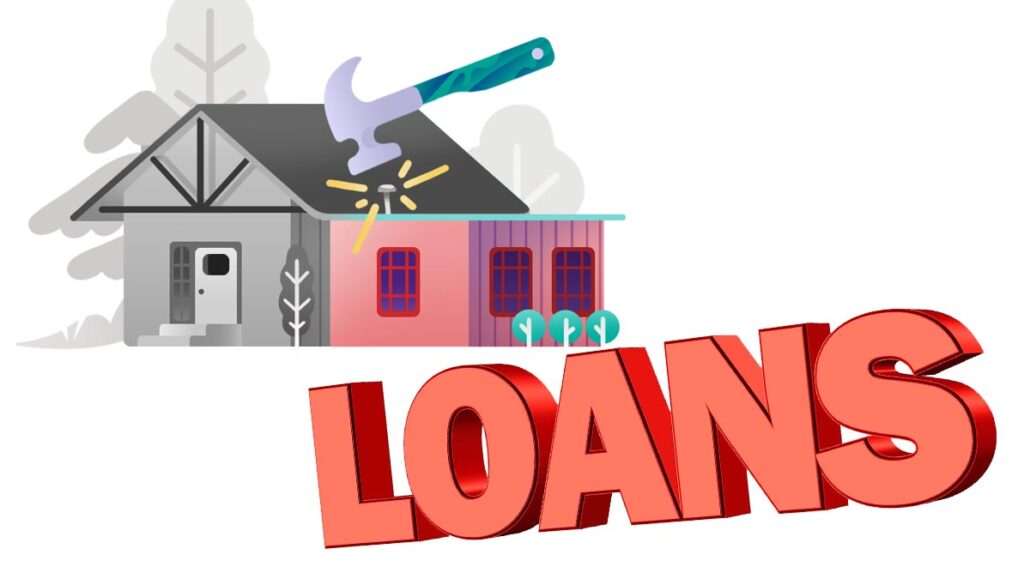Is your home yearning for a refresh? Does that outdated kitchen scream for a makeover, or is that leaky roof whispering woes? Whatever your home improvement dreams may be, you deserve a space that reflects your style and brings you joy. And that’s where home improvement loans step in, like a friendly financial fairy godmother ready to grant your wishes.

Think of a home improvement loan as a magic potion that transforms your to-do list into a reality show of stunning home transformations. It’s a financial tool that empowers you to tackle those big-ticket projects, from replacing cracked windows to building a backyard oasis, without draining your savings account.
But wait, there’s more! Home improvement loans aren’t just about aesthetics. They can also be smart investments that:
- Increase your home’s value: A well-maintained and updated home fetches a higher price tag in the market, making your loan a strategic move for future resale.
- Boost your comfort and energy efficiency: Upgrading your insulation, windows, or HVAC system can lead to lower energy bills and a cozier living environment.
- Enhance your quality of life: Imagine the joy of cooking in a dream kitchen, unwinding in a luxurious bathroom, or entertaining guests in a backyard paradise. Priceless!
Types of Home Improvement Loans
Home Equity Loan:
This trusty steed provides a lump sum of cash secured by your home’s equity. Think of it as unlocking the value you’ve built, paying back in fixed monthly installments over a set term. Ideal for larger projects with a defined scope, like a roof replacement or major renovation.
Home Equity Line of Credit (HELOC):
Picture this as a revolving credit card backed by your home. Access funds as needed, up to a pre-approved limit, and only pay interest on the amount you use. Perfect for ongoing projects, repairs, or unexpected expenses. Remember, discipline is key, as the variable interest rate can fluctuate.
Cash-Out Refinance:
This option involves replacing your existing mortgage with a new one for a larger amount, pocketing the difference in cash. It’s a good choice if you need significant funds and want to potentially secure a lower interest rate on your entire mortgage balance. However, origination fees and closing costs can be hefty.
Personal Loan:
This versatile option doesn’t require your home as collateral, making it a good fit for smaller projects or if you have limited equity. Fixed interest rates and terms offer predictability, but borrowing power might be lower compared to equity-based loans.
FHA 203(k) Rehab Loan:
This specialized loan targets fixer-upper, allowing you to finance both the purchase of the property and its necessary renovations into one convenient mortgage. Ideal for those seeking a fresh start in a home that needs some TLC.
Pros and Cons of Home Improvement Loan
Pros:
- Financing Big Dreams: Home improvement loans provide access to larger sums of money than your average savings account, allowing you to tackle major renovations without exhausting your cash reserves.
- Predictable Payments: Unlike the fluctuating costs of DIY projects, home improvement loans offer fixed interest rates and monthly payments, ensuring long-term financial stability.
- Boosting Your Credit Score: Consistent on-time payments can significantly improve your credit score, paving the way for better loan options in the future.
- Potential Tax Benefits: Depending on the type of project and your tax situation, certain home improvement loans may offer tax deductions, sweetening the financial pot.
- Immediate Upgrades, Lasting Enjoyment: Don’t wait years to experience the comfort and convenience of your dream home. A loan can expedite your project, allowing you to start reaping the benefits sooner.
Cons:
- Debt Dilemma: Adding a loan to your existing financial obligations increases your overall debt burden. Make sure you can comfortably afford the monthly payments without sacrificing other financial priorities.
- Interest Bites: Home improvement loans typically have higher interest rates than mortgages, adding to the total cost of your project. Compare rates and terms from different lenders to secure the best deal.
- Collateral Concerns: Some home improvement loans require collateral, putting your home at risk if you default on payments. Choose a loan type that aligns with your risk tolerance.
- Temptation of Overspending: Easy access to credit can lead to overspending on unnecessary upgrades. Set a strict budget and stick to it to avoid financial strain.
- Unexpected Costs: Renovation projects often encounter unforeseen complications, potentially exceeding your initial budget and loan amount. Factor in a contingency fund to avoid scrambling for additional financing.
Home Improvement Loans Eligibility
Key Factors for Loan Eligibility:
- Credit Score: This three-digit guardian is your financial passport. Aim for a score above 670 for optimal loan terms, but remember, some lenders cater to lower scores with higher interest rates.
- Debt-to-Income Ratio (DTI): This metric reveals how much of your income goes towards existing debts. Ideally, stay below 35% DTI to convince lenders you can handle the additional loan burden.
- Income: Steady income is music to lenders’ ears. Provide proof of income, like pay stubs or tax returns, to demonstrate your financial stability.
- Home Equity: For home equity loans and HELOCs, your home’s equity, the difference between its value and any outstanding mortgage, plays a crucial role. Higher equity translates to lower risk for lenders and potentially better loan terms.
- Project Scope: Lenders want to know what you’re building, not just dreaming. Having a clear project plan with estimated costs shows responsible planning and reduces risk.
Credit Score Requirements for Home Improvement Loans
When considering credit score requirements for home improvement loans, it’s important to understand that the specifics can vary significantly between lenders. However, here’s a general overview:
General Credit Score Guidelines:
- Good Credit (670 and above):
- Borrowers with good to excellent credit scores typically qualify for the most favorable loan terms, including lower interest rates and higher loan amounts.
- These borrowers often have access to a wider range of loan options from traditional banks and credit unions.
- Fair Credit (580-669):
- It’s still possible to obtain a home improvement loan with a fair credit score, but you may encounter higher interest rates and stricter loan terms.
- Some online lenders specialize in working with borrowers in this credit range.
- Poor Credit (below 580):
- Obtaining a home improvement loan with poor credit can be challenging.
- However, some lenders offer loans specifically designed for borrowers with bad credit.
- These loans often come with significantly higher interest rates and fees.
- It is possible to increase your chances of approval by having a co-signer, or by providing collateral.
Documentation Needed for a Home Improvement Loan Application
When applying for a home improvement loan, lenders need to assess your financial stability and the validity of your project. Therefore, they’ll require various documents. Here’s a breakdown of the typical documentation you’ll need:
1. Proof of Identity and Residence:
- Valid Government-Issued ID:
- Driver’s license
- Passport
- Proof of Residence:
- Utility bills (water, electricity, gas)
- Bank statements with your current address
- Lease agreement (if applicable)
2. Proof of Income:
- For Salaried Employees:
- Recent pay stubs (usually the last two or three)
- W-2 forms
- Tax returns (for the past two years)
- For Self-Employed Individuals:
- Tax returns (for the past two years)
- Profit and loss statements
- Bank statements (business and personal)
3. Credit History:
- While the lender will pull your credit report, having a personal copy can be helpful.
- Be prepared to explain any discrepancies or negative entries.
4. Property Documents:
- Proof of Ownership:
- Property deed or title
- Property Tax Statements:
- Recent property tax statements
- Mortgage Statements:
- Current mortgage statements (if applicable)
5. Renovation Plans and Estimates:
- Detailed Project Plans:
- A clear description of the work to be done
- Architectural drawings (if applicable)
- Contractor Quotes/Estimates:
- Detailed estimates from licensed contractors, outlining the scope of work and costs.
6. Financial Documents:
- Bank Statements:
- Recent bank statements (checking and savings) to demonstrate financial stability.
- Debt Information:
- A list of your existing debts (credit cards, loans, etc.)
How to Apply for a Home Improvement Loan
Step 1: Know Your Needs and Numbers
Before diving headfirst into loan applications, take a step back and define your project. What improvements do you need and want? Research contractor estimates to determine a realistic budget. Remember, unexpected costs can arise, so add a buffer to your calculations.
Next, assess your financial situation. Calculate your monthly debt-to-income ratio (DTI). Ideally, it should be below 36% for optimal loan approval chances. Check your credit score, as a good score translates to lower interest rates.
Step 2: Explore Your Loan Options
There’s no one-size-fits-all loan for home improvements. Here are some popular options:
- Home Equity Loans and Lines of Credit (HELOCs): These utilize your home’s equity as collateral, often offering competitive rates and flexible repayment terms.
- FHA 203k Loans: Designed for simultaneous home purchase and renovation, these government-backed loans can be a good option for fixer-uppers.
- Personal Loans: Unsecured loans are ideal for smaller projects, but interest rates might be higher.
- Government Grants and Assistance: Depending on your location and project, government programs might offer financial aid for energy-efficient upgrades or essential repairs.
Step 3: Comparison Shopping for the Best Loan
Don’t settle for the first loan offer you receive. Shop around and compare rates, terms, fees, and repayment options from different lenders, including banks, credit unions, and online lenders. Use online loan comparison tools to simplify the process.
Step 4: Gather Your Paperwork
Once you’ve chosen a lender, prepare your application documents. This typically includes:
- Proof of identity and residence
- Income documentation, such as pay stubs or tax returns
- Bank statements
- Project budget and contractor estimates
- Property appraisal (for some loan types)
Step 5: Submit Your Application and Get Ready to Renovate!
With all your ducks in a row, submit your application and wait for the lender’s decision. Once approved, you can celebrate and start planning your dream renovation. Remember, responsible borrowing is key, so stick to your budget and make your monthly repayments diligently.
How to Compare Home Improvement Loan Rates
Step One: Your Loan Terms
- APR (Annual Percentage Rate): This is your holy grail, the true cost of your loan, including interest and fees. Don’t be fooled by a low headline rate – APR is the ultimate yardstick.
- Loan Term: This is the duration of your repayment marathon. Shorter terms mean higher monthly payments, but less interest paid overall. Conversely, longer terms offer lower monthly payments, but you’ll be paying more in interest over time.
- Origination Fees: These are one-time charges levied by the lender, often a percentage of the loan amount. Negotiate or shop around to minimize these pesky fees.
Step Two: Get Pre-Qualified
Before lenders start throwing loan offers your way, get pre-qualified. This involves a soft credit check and gives you an estimated APR and loan amount you qualify for. It’s like a sneak peek into the loan battlefield, allowing you to strategize and compare offers without dinging your credit score.
Step Three: Compare Rates
Don’t settle for the first knight in shining armor offering a loan. Compare rates from multiple lenders, including banks, credit unions, online lenders, and even your local hardware store. Don’t forget to consider factors like customer service reviews and repayment flexibility.
Step Four: Don’t Be Shy
Armed with your pre-qualification and market research, negotiate like a seasoned warrior. Highlight your stellar credit score and compare your findings with other lenders. Don’t be afraid to walk away – competition is fierce, and the right lender will be willing to fight for your business.
Finding the Right Home Improvement Loan Lenders
- Online Lenders:
- These often offer quick approvals and competitive rates. Examples include SoFi, LightStream, Prosper, and Upstart. They can be a good option for those with varying credit scores.
- Traditional Banks and Credit Unions:
- These institutions, like Wells Fargo, may offer established relationships and potentially lower rates for existing customers. Credit unions, in particular, often provide favorable terms.
- Specialized Home Improvement Lenders:
- Some lenders focus specifically on home improvement loans, offering tailored products and expertise.
- Lending Marketplaces:
- LendingTree, for example, allows you to compare offers from multiple lenders, streamlining the process.
Comparing Home Improvement Loan Rates
- APR (Annual Percentage Rate):
- This is the most crucial factor, as it represents the total cost of borrowing, including interest and fees.
- Fixed vs. Variable Rates:
- Fixed rates remain constant, while variable rates fluctuate with market conditions.
- Loan Terms:
- Shorter terms result in higher monthly payments but lower total interest paid, and longer terms have lower monthly payments, but higher total interest paid.
- Fees:
- Look for origination fees, prepayment penalties, and other potential costs.
- Credit Score Impact:
- Many online lenders offer pre-qualification, which allows you to check potential rates without impacting your credit score.
Using Home Improvement Loans Effectively
Using home improvement loans effectively requires careful planning and execution. Here’s a breakdown of key considerations:
Popular Home Improvement Projects Financed by Loans
- Kitchen and Bathroom Renovations: These projects often yield a high return on investment, increasing both home value and functionality.
- Roof and Siding Replacement: Essential for protecting your home from the elements, these projects enhance curb appeal and prevent costly damage.
- Adding an Addition: Expanding living space can significantly increase home value and accommodate growing families.
- Energy-Efficient Upgrades: Installing new windows, insulation, or solar panels can reduce energy costs and improve comfort.
- Basement Finishing: Transforming unused space into a functional living area adds value and versatility.
How to Budget for a Home Improvement Project
- Create a Detailed Plan: Outline the scope of work, materials needed, and labor costs.
- Obtain Multiple Quotes: Compare estimates from several contractors to ensure competitive pricing.
- Include a Contingency Fund: Set aside 10-20% of the budget for unexpected expenses.
- Prioritize Projects: Focus on renovations that add the most value and address essential repairs.
- Track Expenses: Maintain accurate records of all costs to stay within budget.
Maximizing your Home’s Value with Renovations
- Focus on High-Return Projects: Kitchen and bathroom remodels, as well as exterior upgrades, tend to offer the best ROI.
- Improve Curb Appeal: Landscaping, painting, and new entryways can make a strong first impression.
- Enhance Energy Efficiency: Upgrading appliances and insulation can reduce utility bills and attract environmentally conscious buyers.
- Address Necessary Repairs: Fixing structural issues and outdated systems is crucial for maintaining home value.
- Consider Market Trends: Research what home buyers in your area are looking for.
Avoiding Common Home Renovation Financing Mistakes
- Overborrowing: Only borrow what you can comfortably repay, considering your current and future financial obligations.
- Ignoring Hidden Costs: Factor in permits, inspections, and potential cost overruns.
- Choosing the Wrong Loan Type: Select a loan that aligns with your financial situation and project needs.
- Not Comparing Lenders: Shop around for the best interest rates and loan terms.
- Skipping the Contract: Always get a contract from your contractor that includes all costs, and a project timeline.
- Neglecting to check contractor references: Always check the contractor’s references, and make sure they are licensed and bonded.
FAQs
Is a home improvement loan worth it?
Whether a home improvement loan is worth it depends on your unique circumstances. Consider these factors:
- Project Necessity: Is the improvement essential for safety, energy efficiency, or increasing your home’s value? If it’s purely cosmetic, financing might not be the best option.
- Financial Impact: Can you comfortably afford the monthly payments without straining your budget? Remember, interest adds to the total cost.
- Alternatives: Are there cheaper ways to achieve the same results,
How much can I borrow for a home improvement loan?
Loan amounts vary depending on the lender, your creditworthiness, and the loan type. Secured loans like HELOCs offer higher borrowing power, while unsecured personal loans have lower limits. Generally, expect:
- Personal Loans: Up to $100,000
- HELOCs: Up to 80% of your home’s equity
- FHA 203k Loans: Up to $427,100 for combined purchase and improvements
What’s the best interest rate for a home improvement loan?
The best interest rate depends on your credit score and financial profile. Rates range from around 6% to 36%, so shopping around for the best deal is crucial. Consider:
- Credit Score: A higher score qualifies you for lower rates.
- Loan Type: Secured loans like HELOCs usually offer lower rates than unsecured personal loans.
- Comparison Shopping: Check rates from multiple lenders to find the most competitive offer.
Can I get a home improvement loan with a low credit score?
Getting a home improvement loan with a low credit score can be challenging, but not impossible. Options include:
- Cosigner: Someone with good credit can co-sign the loan, improving your chances of approval and potentially lowering the interest rate.
- Smaller Loans: Start with a smaller loan that’s easier to qualify for and build your credit score with timely repayments.
- Government Programs: Explore government-backed loan programs like FHA 203k, which are more lenient on credit scores.
Remember, borrowing for home improvements is a financial decision. Weigh the pros and cons carefully, research your options, and choose a loan that fits your budget and creditworthiness.

